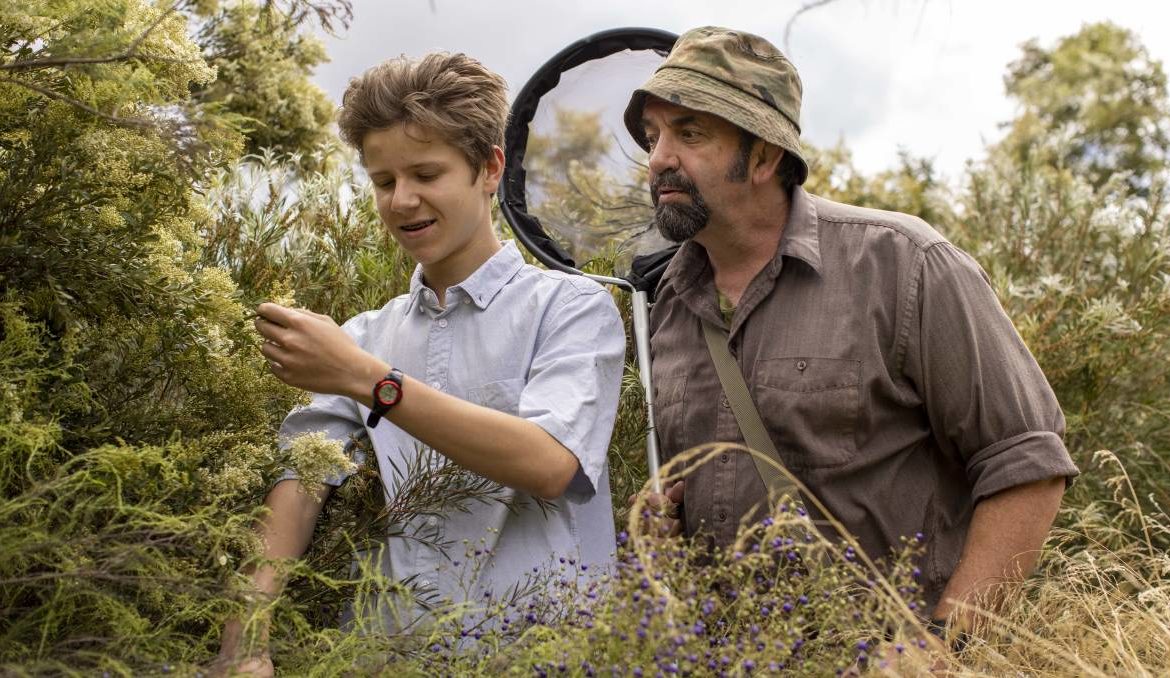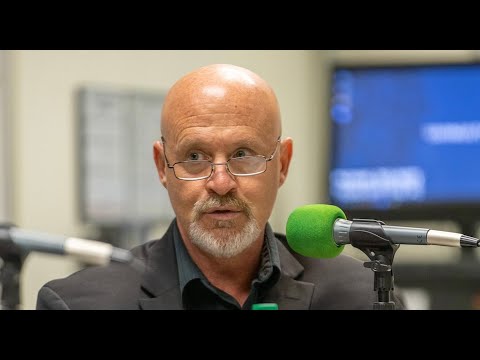news, latest-news, citizen science, jewel beetle, Castiarina testacea, Selagis aurifera
A chance stop on a round-the-lake bike ride led to the rediscovery last week of a rare beetle, not seen in Canberra for more than six decades. Luke Downey, a 14-year-old from Wamboin, stopped in at the environment meditation and healing garden near Menindee Drive on the north-eastern side of Lake Burley Griffin last Saturday. The garden’s Bursaria spinosa shrubs, in flower for only a few weeks at the start of the year, were the perfect hunting ground for keen citizen scientists. In the flowers, Luke found a jewel beetle – Castiarina testacea – a rare and unusual beetle, hardly seen so far east on the Australian continent. “I was really surprised and I was like, ‘Wow’. And I didn’t expect to be doing it on a bike ride. And I was pleasantly surprised and I was just happy. And I was like, ‘Oh yeah, this is amazing’. And I actually found more. It was great,” Luke said. A bumper season has given rise to other unique sightings, including budgerigars seen flying in Canberra for the first time in living memory. The last known sighting of the beetle in Canberra was made in 1955, when it was recorded at Casuarina Sands. That find was made by leading entomologist Dr George Bornemissza, who led the CSIRO’s introduction of the dung beetle to Australia as part of an effort to reduce the number of flies across the country. Dr Bornemissza, who died in 2014 aged 90, was a world-leading beetle expert, who also compiled beetle collections for the Australian National Insect Collection in Canberra. Stuart Harris, a fellow citizen scientist and photographer who has helped Luke identify his discoveries, rushed to the garden after the jewel beetle was found. Mr Harris was able to capture photographs of the jewel beetle, along with Selagis aurifera – another rare beetle to find in the ACT; its Latin name means white gold. Luke recorded his jewel beetle find in the Canberra Nature Map, an online repository where citizen scientists recorded sightings of rare plants and animals in the ACT. “I started doing citizen science stuff five years ago now and beetles is more recent. In the last year or so I’ve been looking for more beetles,” Luke said. “I always enjoyed nature and natural stuff. My dad said, ‘Maybe you could get involved with this’. I looked at it and I thought, ‘Yeah, that’s a really good idea’. So I did. I began doing citizen science stuff.” Luke said meeting other people who were also interested in finding rare and unusual flora and fauna was an exciting part of participating in the project. “Finding anything that’s just new or unusual is always interesting. It’s really nice to know that you’ve found something that might be important for science,” he said. Luke said it was always worth stopping to have a look in any pockets of natural environment, even if you did not know what you were looking for. “If you’re interested or even if you’re just passing by, it’s great to look at it. Even if you don’t know what you’re looking at. A lot of the things are just interesting and they look cool and strange,” he said. Mr Harris said there was no better place to be than outdoors on a sunny day in Canberra looking for wildlife. A species of peacock spider – Maratus harrisi – was named after Mr Harris, who first came across the spider in the Namadgi National Park in 2008. “You do get your Holy Grails. This year there’s been a few Holy Grails turn up. There isn’t one Holy Grail. It’s just a remarkable season that so much new stuff has turned up. Not just with jewel beetles, but all sorts of invertebrates. Birds, even,” Mr Harris said. Mr Harris said a bumper season – there were plenty of flowering plants following recent rain – had created many opportunities to go searching in the bush for yet-to-be found natural wonders. “As a human you go into the bush and it tends to balance you, it calms you. It’s green therapy, whatever they call it now,” he said.
/images/transform/v1/crop/frm/35sFyBanpD896MKnAH5FRtj/d66c40df-b6d4-4100-8d6b-aff12259d3f1.jpg/r20_437_8172_5043_w1200_h678_fmax.jpg
A chance stop on a round-the-lake bike ride led to the rediscovery last week of a rare beetle, not seen in Canberra for more than six decades.
Luke Downey, a 14-year-old from Wamboin, stopped in at the environment meditation and healing garden near Menindee Drive on the north-eastern side of Lake Burley Griffin last Saturday.
The garden’s Bursaria spinosa shrubs, in flower for only a few weeks at the start of the year, were the perfect hunting ground for keen citizen scientists.
In the flowers, Luke found a jewel beetle – Castiarina testacea – a rare and unusual beetle, hardly seen so far east on the Australian continent.
“I was really surprised and I was like, ‘Wow’. And I didn’t expect to be doing it on a bike ride. And I was pleasantly surprised and I was just happy. And I was like, ‘Oh yeah, this is amazing’. And I actually found more. It was great,” Luke said.
A jewel beetle – Castiarina testacea – found near Lake Burley Griffin. Picture: Stuart Harris
A bumper season has given rise to other unique sightings, including budgerigars seen flying in Canberra for the first time in living memory.
The last known sighting of the beetle in Canberra was made in 1955, when it was recorded at Casuarina Sands.
That find was made by leading entomologist Dr George Bornemissza, who led the CSIRO’s introduction of the dung beetle to Australia as part of an effort to reduce the number of flies across the country.
Dr Bornemissza, who died in 2014 aged 90, was a world-leading beetle expert, who also compiled beetle collections for the Australian National Insect Collection in Canberra.
Stuart Harris, a fellow citizen scientist and photographer who has helped Luke identify his discoveries, rushed to the garden after the jewel beetle was found. Mr Harris was able to capture photographs of the jewel beetle, along with Selagis aurifera – another rare beetle to find in the ACT; its Latin name means white gold.
Luke recorded his jewel beetle find in the Canberra Nature Map, an online repository where citizen scientists recorded sightings of rare plants and animals in the ACT.
A Selagis aurifera beetle found near Lake Burley Griffin. Picture: Stuart Harris
“I started doing citizen science stuff five years ago now and beetles is more recent. In the last year or so I’ve been looking for more beetles,” Luke said.
“I always enjoyed nature and natural stuff. My dad said, ‘Maybe you could get involved with this’. I looked at it and I thought, ‘Yeah, that’s a really good idea’. So I did. I began doing citizen science stuff.”
Luke said meeting other people who were also interested in finding rare and unusual flora and fauna was an exciting part of participating in the project.
“Finding anything that’s just new or unusual is always interesting. It’s really nice to know that you’ve found something that might be important for science,” he said.
Luke said it was always worth stopping to have a look in any pockets of natural environment, even if you did not know what you were looking for.
“If you’re interested or even if you’re just passing by, it’s great to look at it. Even if you don’t know what you’re looking at. A lot of the things are just interesting and they look cool and strange,” he said.
Mr Harris said there was no better place to be than outdoors on a sunny day in Canberra looking for wildlife.
A species of peacock spider – Maratus harrisi – was named after Mr Harris, who first came across the spider in the Namadgi National Park in 2008.
“You do get your Holy Grails. This year there’s been a few Holy Grails turn up. There isn’t one Holy Grail. It’s just a remarkable season that so much new stuff has turned up. Not just with jewel beetles, but all sorts of invertebrates. Birds, even,” Mr Harris said.
Mr Harris said a bumper season – there were plenty of flowering plants following recent rain – had created many opportunities to go searching in the bush for yet-to-be found natural wonders. “As a human you go into the bush and it tends to balance you, it calms you. It’s green therapy, whatever they call it now,” he said.







